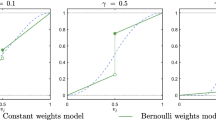Abstract
In a stylized environment with complementary products, we study a class of dominant strategy implementable direct mechanisms and focus on the objective of minimizing the expected surplus from core deviations. For this class of mechanisms, we formulate the core deviation minimization problem as a calculus of variations problem and numerically solve it for some interesting special cases. We then compare the core deviation surplus in the optimal auction (CDMA) to that in Vickrey-Clark-Groves mechanism (VCG) and core-selecting auctions (CSAs). We find that the expected surplus from core deviations can be significantly smaller in CDMA than that in both VCG and CSAs.


Similar content being viewed by others
Notes
Also, VCG revenues are non-monotonic with respect to the number of bidders or their valuations.
Ausubel and Baranov (2010) review and illustrate the payment rules in Nearest–Vickrey, Proxy, Proportional pricing, Nearest-Bid and First-price package auctions.
The core property does not imply collusion-proofness [in the sense of Marshall and Marx (2007) and Ausubel and Milgrom (2002)]. For instance, the outcome in a single object second-price auction is in the core, but bidders can collude by bidding less in the auction and reallocating among themselves, or the seller and the second-highest bidder can both benefit if the seller pays the bidder a few pennies to bid a dollar higher. Moreover, in the stylized model where two objects are allocated among two local and one global bidders via VCG, two local bidders can bid artificially high, win their respective items, and pay zero. These kinds of deviations are not considered in our formulation. These observations imply that our results should be interpreted with caution, as we only allow for deviations in which the seller and subset of buyers could divide the available social surplus among themselves and we do not consider their joint manipulation within the given mechanism. In this sense, we consider only the mechanisms that are strategy-proof, but not necessarily those that are group strategy-proof.
See Beck and Ott (2013) for a discussion of equilibria in minimum revenue CSA.
The assumption in (2) is essential for the results we present in this paper. While being somewhat restrictive, it is at the same time quite reasonable as the allocation rule treats local buyers symmetrically and takes as inputs the value of the global buyer and the aggregate values of local buyers. When information is private, this assumption is satisfied in equilibrium by VCG but not by CSAs. In equilibrium, CSAs’ allocation rules also treat local buyers symmetrically, but they positively favor the global buyer in a more complex way than CDMA does. This follows because CSA allocations depend on the individual values of the local buyers and not simply on their aggregate.
Note that \(T_{i}( 0,v_{-i}) \) cannot be positive because otherwise individual rationality constraint of buyer \(i\) of type \(0\) is violated\(.\) If, on the other hand, \(T_{i}( 0,v_{-i}) \) is strictly negative, then we can subtract that number from the payments of buyer \(i\), which will not change \(i\)’s incentive constraints, but decrease the value of the objective function.
The intuition from Proposition 2 and eqnarrays (5)–(6) suggest that CDMA could be implemented or, at least, approximated using a “Vickrey preference (or handicap) auction”–a modified Vickrey auction—that nonlinearly deflates the bids of the local bidders to determine the winner and the price winning global bidder pays and nonlinearly inflates the bid of the global bidder (while keeping the bids of locals the same) to determine the price winning local bidders pay.
References
Ausubel LM, Baranov OV (2010) Core-selecting auctions with incomplete information. Working paper, University of Maryland
Ausubel LM, Milgrom P (2002) Ascending auctions with package bidding. Front Theor Econ 1(1):1–42
Baranov OV (2010) First-price package auctions with incomplete information. Working paper, University of Maryland
Beck M, Ott M (2013) Incentives for overbidding in minimum-revenue core-selecting auctions. Working paper, Stanford University
Cramton P (2013) Spectrum auction design. Rev Ind Organ 42(2):161–190
Day RW, Cramton P (2012) The quadratic core-selecting payment rule for combinatorial auctions. Oper Res 60(3):588–603
Day RW, Raghavan S (2007) Fair payments for efficient allocations in public sector combinatorial auctions. Manag Sci 53:1389–1406
Day RW, Milgrom PR (2008) Core-selecting package auctions. Int J Game Theory 36:393–407
Erdil A, Klemperer P (2010) A new payment rule for core-selecting package auctions. J Eur Econ Assoc 8:537–547
Goeree JK, and Lien Y (2012) On the impossibility of core-selecting auctions. Working paper, University of Zurich
Lamy L (2010) Core-selecting package auctions: a comment on revenue-monotonicity. Int J Game Theory 39:503–510
Marshall R, Marx L (2007) Bidder collusion. J Econ Theory 133(1):374–402
Sano R (2010) Incentives in core-selecting auctions with single-minded bidders. Games Econ Behav 72:602–606
Acknowledgments
We would like to thank the associate editor and two anonymous referees for their insightful and constructive comments that immensely improved our paper. We are grateful to Bilkent University for hosting us during the early stages of this research. We also thank Gokhan Apaydin and Mohamad Maleki for discussions about numerical optimization and Ersin Korpeoglu for excellent research assistantship. Hafalir acknowledges financial support from National Science Foundation Grant SES-1326584.
Author information
Authors and Affiliations
Corresponding author
Electronic supplementary material
Below is the link to the electronic supplementary material.
Rights and permissions
About this article
Cite this article
Hafalir, I.E., Yektaş, H. Core deviation minimizing auctions. Int J Game Theory 44, 367–376 (2015). https://doi.org/10.1007/s00182-014-0433-y
Accepted:
Published:
Issue Date:
DOI: https://doi.org/10.1007/s00182-014-0433-y




